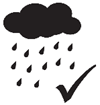Revised August 2024
Safe Use of Power Tools in Rain Guidelines and Best Practices
For years, standard practices for lithium-ion tool systems have recommended usage in dry conditions only. However, recent improvements in lithium-ion battery technology and the power tool safety standards now allow some battery and tool combinations to withstand exposure to rain. Before using any power tool or battery in the rain, there are several Important Guidelines and Best Practices to be followed.
Each component of a power tool system (power tool, battery, and charger*) that has been tested and found suitable for use in rain will be marked with either the symbol below symbol or text (e.g., IP Rating IPX 4 or higher), or provided with information in the product's operator's manual, indicting its suitability for exposure to or use in rainy conditions.

Important Guidelines:
- Ensure the tool, battery, and charger are recommended by the manufacturer to be used together.
- Ensure each component of the system (e.g. the lithium-ion battery pack, tool, and charger) is suitable for use in rain
- Only use combinations that are recommended by the manufacturer and properly marked for use in rain.
Just because one component of the system, such as the battery, is marked as suitable for use in rainy conditions does not mean all components that can be connected together are a suitable combination for rainy conditions. Reading and understanding the manufacturer's recommendations, warnings, and instructions is essential to avoid risks such as injury, fire, or electrical shock.
Best Practices for Operating in Rainy Conditions:
- Operating Instructions: Always read the operator's manual and on-product markings provided with the product and following included warnings and instructions for proper use.
- Weather Conditions to Avoid: Do not operate tools in severe weather conditions, such as dense fog, lightning, high winds, extremely cold rain, or emergency conditions.
- Safety Equipment: Always wear appropriate PPE and work apparel suitable for the conditions.
- Visibility and Stability: Ensure good visibility of work piece and surrounding area. Also ensure proper footing and stability can be maintained throughout the entire process.
- Handling: Keep tool handles and controls dry to maintain proper grip and control.
- Battery Care: Avoid exposing battery interfaces to rain and do not remove the battery pack in wet conditions. If the battery gets wet, allow it to dry completely before recharging or using it with products not suitable for use in rain.
- Other Moisture: Only rain (fresh water) exposure is acceptable. Never immerse the battery in any liquid or allow salt water or other corrosive or conductive fluids to contact it, as this could cause short circuits, fires, or explosions.
- Cleaning: Avoid using high-pressure water jets to clean the tool system, as this could force water into components and cause damage.
Following the manufacturer's warning and instruction and these important guidelines and best practices can help ensure the safe exposure or use of lithium-ion battery tools in rain.
*Please note there are no markings at this time for battery chargers. Charging should always be done in dry conditions, unless the charger's operator manual states it can be used in wet conditions.
